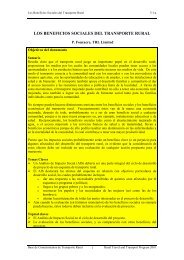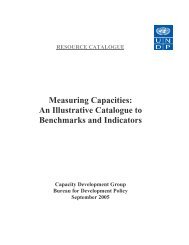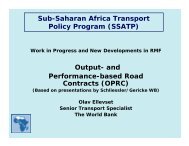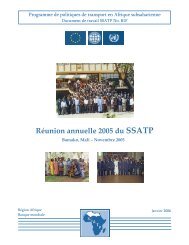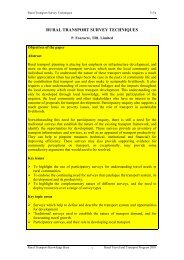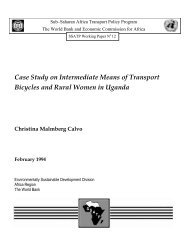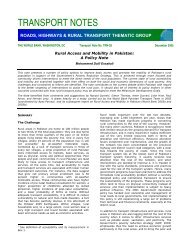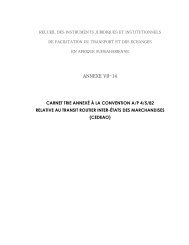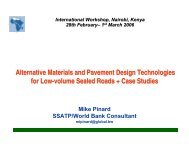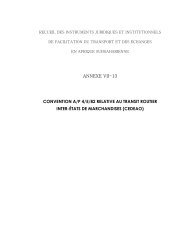Rural Transport Training Materials CD-ROM. Module 2 - World Bank
Rural Transport Training Materials CD-ROM. Module 2 - World Bank
Rural Transport Training Materials CD-ROM. Module 2 - World Bank
You also want an ePaper? Increase the reach of your titles
YUMPU automatically turns print PDFs into web optimized ePapers that Google loves.
<strong>Rural</strong> <strong>Transport</strong> <strong>Training</strong> <strong>Materials</strong><strong>Module</strong> 2:Planning, Design, Appraisal andImplementationParticipatory ruralplanning processesSession 2.1Part 1Presentation 2.1a
The <strong>Training</strong> <strong>Module</strong>s<strong>Module</strong>1. Policies and StrategiesThis <strong>Module</strong><strong>Module</strong> 2. Planning, Design, Appraisal andImplementation<strong>Module</strong> 3. Management and Financing<strong>Module</strong> 4. <strong>Rural</strong> Mobility<strong>Module</strong> 5. Social and Environmental Issues
<strong>Module</strong> 2. Planning, Design, Appraisaland ImplementationThis sessionSession 2.1 Participatory rural planning processSession 2.2 Design of rural transport infrastructureSession 2.3 <strong>Rural</strong> road economic appraisal methodologySession 2.4 Labour-based works methodologySession 2.5 Small scale contractor developmentSession 2.6 Community Participation in <strong>Rural</strong> <strong>Transport</strong> InfrastructureSession 2.7 Participatory Survey Techniques for <strong>Rural</strong> <strong>Transport</strong>
1. IntroductionLearning ObjectivesThis session enables participants to:Explain the need for a holistic approach to transportinterventionsDescribe the 9 key stages in Participatory <strong>Rural</strong>Planning (PRP)Analyse policy, organisational and institutional issues inaccessibility planningExplain how the availability of various types ofresources affect the planning and implementation ofinterventionsDevelop check lists of the key issues that should beconsidered during monitoring, evaluation, planning,implementation stages
Session OverviewParticipatory rural planning (PRP): overviewParticipatory rural planning (PRP): theprocessInstitutional arrangementsResource issuesMonitoring and evaluation
2. Participatory <strong>Rural</strong> Planning: overviewAn effective way to reduce poverty is to improve:• the mobility of the rural population• their access to employment opportunities & othersocio-economic services and facilitiesIntegrated rural transport considers a wider range oftransport interventions• paths and tracks• intermediate means of transport (IMT) andtransport services to complement the conventionalinterventions in roads and motorised vehiclesParticipatory <strong>Rural</strong> Panning (PRP) is a new approach to ruralaccess planning.
Participatory <strong>Rural</strong> Planning (PRP)in a nutshellDeveloped & improved through studies/ pilotprojects in Africa & AsiaMulti-sectoral and integrated approach• considers all aspects of household access needsfor subsistence, economic and social purposesIdentifies development needs, problems andpriorities• … which can be addressed by improving accessto facilities and services …• by facilitating movement of people to theseservices (transport improvement), or• bringing the services closer to the people throughcarefully rationalised site selection procedures
Provides a menu of alternative solutionsStarting point is understanding the accessneeds and magnitude of transport activity ofrural householdsDetermines priorities for access improvementsIdentifies the most effective means ofachieving access improvementsIntegrates• rural households' mobility needs• siting of essential social and economic services• provision of appropriate transport infrastructureInvolves communities
Based on a thorough but easy-to-execute datacollection system• uses households as a focus of the planning processIncludes gender issuesSimple to useDoes not require substantial resourcesBottom up approach to planning• links to the planning structure at the district levelHigh priority to the protection of theenvironment
PRP - Key Concepts: AccessThe approach argues that …poor access to facilities leads to isolation –a major factor contributing to poverty.<strong>Rural</strong> accessibility planning definesaccess needs of rural households in relation tothe basic social and economic servicesrequired by a household.
PRP - Key Concepts: MobilityMobility needs focus on:Purpose for which people travelAvailability of public transport servicesCondition of the transport infrastructure, i.e.local level roads, footpaths, footbridges, etc.Means by which people transport themselvesand their goods• foot, bicycles, animal carts, donkeys,wheelbarrows etc. (level of mobility)The availability of social and economicservices in relation to population density
3. Participatory <strong>Rural</strong> Panning (PRP)The ProcessA. Interventions to improve accessibilityB. Key stages in Participatory <strong>Rural</strong>PlanningC. Institutional arrangementsD. Resources issuesE. Monitoring and evaluationCredit: TRL Limited
A. Interventions to improve accessibility<strong>Rural</strong> transport infrastructure improvements<strong>Rural</strong> transport mobility improvementsImproved enabling environment for ruralmobility e.g. through credit facilities andtrainingMore accessible locations/ sites of facilitiesand services• e.g. water supplies, schools and health facilitiesEnvironmentally friendly measures• e.g. improved ovens and development of woodlots
B. Participatory <strong>Rural</strong> Planning (PRP)The PRP methodology leads to:Development of comprehensive information on• location, condition & use of rural infrastructure and services• investment priorities• range of access interventionsEmphasis on building local capacity and the use oflocal resources (material and human) in theimplementation and maintenance of locally initiatedprojects, including• adoption of appropriate technologies and labour intensivemethodologyA set of defined and prioritised interventions thataddress the access needs of the rural population
Key stages in PRP1. Development of a Local Government <strong>Transport</strong>Master Plan (LGTMP)2. Identification and consultation of keystakeholders3. Define planning objectives4. Define rural access needs that relate to theseobjectives5. Collect data on relevant access needs &priorities, and produce Accessibility Database6. Define the main access problems7. Define strategy to address access problems8. Prioritise locations of specific interventions9. Consolidate prioritised interventions to produceaction plans
Key stages ofParticipatory <strong>Rural</strong>Planning (PRP)Group ActivityExploring the issues related to eachstage in Participatory <strong>Rural</strong> Planning(PRP)Activity Sheet 15
1. Development of a Local Government <strong>Transport</strong>Master Plan (LGTMP)Set out as part of the national sector policy oras part of an explicit national rural transportpolicy and strategyMay be prepared by• local government planning agencies incollaboration with the communities and assistedby local consultants• contracted out to experienced consultants by localgovernment or community representativescombined in ‘joint-services’ committees
2. Identification and consultation ofkey stakeholdersEstablish liaison between those groups ofpeople who have different interests in theprojectPrimary stakeholders = those groups whosesocial and economic livelihoods will beaffected directly by the project• e.g. travellers, market traders and transportoperators
2. Identification and consultation ofkey stakeholdersOther interest groups = their own lives willnot be affected directly by the project, but areimportant in the decision-making process• district leadership, district's works agencies andthe department of feeder roadsGo beyond the leadership• leaders’ standpoints can differ significantly fromthe experiences of ‘average’ village members
Key Stakeholders in Local Government<strong>Rural</strong> <strong>Transport</strong> InfrastructureNational LevelGovernment agencies and their regional and/ordistrict counterparts are usually involved insuch projects, e.g., Ministry of <strong>Transport</strong>,provincial road agency, district road agency,municipal planning organisations<strong>Transport</strong> User GroupsCommunity groups, farmer’s associations, roaduser and transport associations, agroprocessors
Key Stakeholders in Local Government<strong>Rural</strong> <strong>Transport</strong> Infrastructure<strong>Transport</strong> provider/ supplier groups• Local-government service ministries, investors,donors, NGOs, community organisations, privatesector (transport suppliers)Directly affected groups/ vulnerable groups• Project-affected persons: resettled populations,indigenous peoples, ethnic groups, squatters,encroachers, street vendors, women, pensioners,the elderly, students, childrenOther stakeholders• Donors, labour unions, media, chambers ofcommerce, research institutes, banks or financialinstitutions
3. Define planning scope, aim & objectives of thePRPSet the scope• e.g. which sectors to include in the planning and whattargets to meetThe scope should be within sectors that:• provide services that households need to travel regularly to• provide an infrastructure• facilitate the availability of internal means of transportThe aim• is to minimise the time, cost and effort spent by rural peoplein getting access to goods and servicesThe objective• is to ensure that access to essential goods and services ofthe rural households is improved
Operational objectivesTo facilitate access to women and men in the ruralareas to goods and services required to satisfy basicneedsTo reduce the need for walking & human porteragefor both women and men in all of their activities• productive, reproductive and socialTo improve the quality of life for rural women & menby greater access to better means of travel andtransport• by addressing technical, economic and cultural constraintsTo involve rural women and men in the planning,implementation and maintenance of rural transport.
Major questions to be askedWho will benefit?….. and will women's needs be addressed ifthe objectives do not spell out the needs ofboth men & women?Questions on Policy ObjectivesWho are the intended beneficiaries?Do the objectives take into considerationgender differences in travel and transportneeds?Do they consider all the travel and transportneeds or only some e.g. agriculture?
4. Defining rural access needs relating to planningobjectivesPeople need to travel for different purposesConsider needs from all sectors/ groups of peopleBaseline data:• is the foundation of the accessibility planning procedure• provides the main source of information in identifyingpriorities for interventions to improve transport and accessto services & facilitiesBut!The usefulness of base line data for decision makingdepends on its reliability and accuracy.
5. Data collection and compilationCollect information on a range of accessneeds• as relates directly to the accessibility of ruralhouseholds to facilities, goods and servicesA baseline survey helps build up anAccessibility Database at two levels:district levelvillage levelCompilation of data and analysis
Aims of data collection at the district levelDefine socio-economic conditions: within the districtthat relate to transport and accessibility for the wholeof the districtWider context: in which the findings from villagesurveys can be placed• enables comparisons with conditions in other parts of thedistrictQuality control: provide a basic crosscheck oncertain items of village level dataLesson learning: draw on lessons from interventionsin a particular area and share good practice• that can be modified for application in other project areas
District level dataBasic characteristicstotal populationpopulation distributiondemographyDistribution of facilitieshealthschoolsetc.Economic activitiesagricultureincomegeneration
District level data<strong>Transport</strong> infrastructuredistribution ofroad network<strong>Transport</strong> servicesnumbers & typesof vehicleDevelopment activitiescurrent conditionplanned &ongoing projectsgroups activein districtroutesfrequency ofoperationfare structureavailability of IMT
The aim of collecting data at the village level is tobuild a picture of:Basic physical and socio-economic characteristicsof each villageMagnitude and pattern of rural household transportdemand:• amount of time taken to get to a facility or service• frequency of trips to a facility/ service• mode of transport used for different trip purpose• distribution of various transport responsibilities within thehousehold among men, women and childrenExisting state of rural transport facilities and presentlevel of access to goods and services for eachvillage
Village level dataVillage level data =• primary data• useful picture of actual needs in the rural areas• complements district level dataSecondary data from the district level givessome indication of accessibility conditions ...but!The bulk of the information should becollected from the communities.
Compilation of data and analysisCompile data as averages, in tables, maps anda descriptive reportFormats may show:• background information on economic, geographicand demographic characteristics• main economic activities in villages and district• extent and quality of transport infrastructure• average time taken to each facility/ service for eachvillage• location of various facilities on a map• average ownership of and access to various meansof transport in each village, and level of transportservices• needs/ priorities as expressed by the community
6. Define the main access problemsThe aggregation of village and district level dataallows each district, ward and village to be classifiedusing Accessibility IndicatorsAccessibility Indicators relate to the:• number of households and their level of access togoods and services• distance between communities and services• time it takes to reach the services and facilitiesAccessibility Indicators identification of mainaccess problems and prioritisation of interventions
Accessibility Indicators are ...Defined for access needs:• water• fuel wood• land for crop production• crop processing• education• health• agricultural inputs• markets, retail and small industries
Calculating accessibility indicators... relates thenumber of households to the timeit presently takes to access services/ facilitiesThe basic formulation accessibility indicator is:H x TH = Number of households that need access to acertain service facility/ serviceT = The amount of time it takes to reach the service/facility
For example …There are 40 households in a village who haveto travel to get water,the average time for a return trip is 120 minutesThe accessibility indicator for water in thatvillage would be:40 x 120 = 4800
For district planning the accessibilityindicators …Show which villages have more accessproblems for specific servicesA village scoring high on water means• the amount of time taken to get water is more, or• there are more people who have to travel to getwater, or• both of theseThis village would have a higher priority forimproving access• relative to another village with a smaller score
A gender perspectiveDifferentiate scores by women and men• Number of women x time taken x score for means of transport• Number of men x time taken x score for means of transportWeight score according to means of transportshorter distancetravelled on footover steep hillsscores higher thanlonger tripby busThe more difficult the means of transport = the higher thescore, e.g.• walking on steep hills = 5• walking on flat roads = 3• using donkeys = 2• using motorised vehicles = 1
7. Define strategy to address access problemsTwo categories1. Closer proximity to essential services2. Increasing the accessibility to services byimproving the transport systemAccessibility planning looks at the wholerange of possible solutions and provides anopportunity for selecting one or a combinationof the most appropriate ones.
8. Prioritise locations of specific interventionsThis stage:Deals with where interventions are going tobe introducedConcerns identification and selection ofroads, villages and wards for specificmeasuresAccessibility Indicators give an overview of theaccess situation: the degree to which• different sectors are affected by access problems• a village is affected by a particular access need
9. Consolidate prioritised interventions to produceaction plansResponsibility lies with the District Planner• in consultation with officers from the concerned sectors• representatives from NGOs and other organisationsAccessibility planning• offers a common framework for all sectors to plan togetherfor implementation• uses a common procedure for identifying problems andoffering solutionsDiscuss analysed results with all district officials• new insight into access problems in different areas in theirdistrict• involves them in preparation of a coherent plan of action fortheir district.
4. Institutional Arrangements1. Policy issues in accessibility planning<strong>Rural</strong> accessibility concerns cut across manysectors - water, health, and educationService provision is defined using targets ofdistance and catchment populationFor example:• a primary school for every village with 250 households -maximum distance to the facility should not exceed 3km• a clean water supply should be installed for every 200-250 people - distance to safe drinking water should notexceed 400m.• a woodlot should be available for every household
2. Organisational issues in accessibilityPlanningVaries from country to country – the process of PRPwill have to be adapted to suit each.Typical example: Tanzania3 tiers of local development planning:Village CouncilWard Development CommitteeDistrict CouncilThe purpose of these structures:a. decentralise powerb. devolve decision making powers to representativeinstitutions within the district
Tanzanian exampleVillage Council17 - 25 members depending on size of the villageExecutive powers for all affairs in the villageCommittees for:• Finance, Planning and Economic Affairs, Social Servicesand Self-Help Activities, and Domestic SecurityOther committees may be established as requiredThe village body initiates proposals for developmentprojects in its own area and sends them upwardthrough the government planning hierarchy
Composed of:Tanzanian exampleWard Development Committee• elected members of the district representing theward (Councillor)• public officers seconded to the ward• chairpersons and secretaries of all VillageDevelopment Committees within the ward• the Ward Executive OfficerFunctions:• making decisions over development activitieswithin the ward• ensuring their implementation
District CouncilTanzanian exampleComposed of:• elected member from each ward in the district• 3 members elected by the Minister responsible forlocal government• member(s) of parliament representingconstituencies within the district• other members elected by the district council fromamong the chairpersons of village councils &include the District Executive Director who issecretary to the councilFunction:• promote the social and economic welfare of allresidents in a district, subject to the nationalpolicy for rural and urban development
The District Council is:Subdivided into standing subcommittees:• finance and planning• administration and establishment• social services• education affairs• economic servicesKey lessons<strong>Rural</strong> accessibility planning needs to beinstitutionalised within the present district planningstructure.This entails building of capacity within the village,ward and district for identification of access problemsand formulation of solutions.
Institutional Relationshipsassociated withParticipatory <strong>Rural</strong> Planning(PRP)Venn Diagram ActivityAnalyse the relationships between keystakeholders and institutions.Activity Sheet 16
Resources:5. Resource IssuesInputs required to initiate and sustain an activityDefine the limits of what can be achieved, and theextent to which it can be achievedWhat is required related to availability = an importantelement of the planning processPlanners require information on:Available fundsPersonnel and skillsEquipmentAbility and willingness of villages to pay forinterventions
Key resource considerationsCentral governmentMajor source of revenue for villages and districtsAllocation from this source is usually arbitrary, or isbased on allocations in the previous yearFunding largely goes to meet recurrent expenditureof the District Council• leaving little for investment in new activities or operation ofalready existing onesTo prevent this from happening in accessibilityplanning:Screen proposals at each level• to ensure that they are not based on unavailable resourcesDistrict planners should seek the contribution ofother actors• NGOs, private sector and local groups
6. Monitoring and EvaluationPurposeTo provide the District Planning Officer withinformation to assess progress of implementationand changes taking place in the environment fortimely decision makingMonitoring covers two broad elements:Progress of the process of implementation• efficiency in delivery and use of inputsProgress against defined targets• physical outputs of the activities• impact they have had on target communities
Monitoringand PRPGroup DiscussionA. What should be monitored when planning ruralaccess interventions?B. What should be monitored when implementingaccess interventions?C. How can we ensure that monitoring data isgender sensitive?D. How can the monitoring data best be used byPlanners?Activity Sheet 17
1. Monitoring & evaluation atthe planning stageMonitor gender issues:identifyaccessibility factorsandprioritising interventions
Monitor the quality of data with respect to:Disaggregate data by genderParticipation of women in the information gatheringprocess as informantsObtain opinions of both genders on the most seriousaccess problemsSpecial constraints of women in access to transportinterventionsGender sensitisation needs at district and local levelInstitutional needs such as <strong>Transport</strong> Committees atward and village level in which there is a fairrepresentation of both gendersIdentified training needs and who are the targets
Accessibility Indicators help in• Determining the nature, scope, magnitudeof the problem• Defining the desired situation• If, for example, access to water scoresvery high on the Indicator, accessimprovement measures would aim atlowering the indicator by a set target level
2. Monitoring and evaluation atthe implementation stage1. Progress of physical outputs according toplanned schedule2. Defined priorities and targets - being metthrough the physical outputs of theactivities?3. Achievement of objective of reducing thetime and effort in travel and transport• especially for women
2. Monitoring and evaluation atthe Implementation StageNote:1 & 2 are easy to assess against set plansof actions & schedules of work3 is complex because women mightincrease the visits to a facility if it isconveniently closer• e.g. when a water supply point is located in thevillage, women tend to collect more water• so the benefit is not in terms of the time savedbut in better sanitation and health
3. Monitoring the impact ofthe intervention on WomenPositive impacts on women:Potential increases in income• time saved is used on productive/ socialactivitiesReduced headloads carriedRedistribution of workload• e.g. an animal-drawn cart is used by men to carrywater or take the grain to the mill
Negative impacts on women:Increased travel time and transport• e.g. afforestation/ agro-forestry projects becausethe work is not equitably divided among womenand men.Preferences ignored• e.g. the prioritised access need was for pathimprovement to the fields … but a path was madeto a district road (men's preference)Impact on women’s travel and transport loadneed/ headloading• due to their inability to afford to purchase/ hire thetransport facilities
4. Ability to respond to data frommonitoring and evaluationFlexibility of planning• alternative strategies available - if the interventionis having a negative impact• e.g. if donkeys are not available for sale to takethe produce to the market, can the village accessroad be improved to entice motorised transport tocome to the village?
4. Ability to respond to data frommonitoring and evaluationNo better alternative?• district personnel must visit the site• find ways with the villagers to keep the project ontrack• involve women fully• more equitable sharing of the tasks between men& women‣….. so that all the free labour is not provided by thewomen alone!
4. Ability to respond to data frommonitoring and evaluationFeedback mechanism to link monitoring andplanningReview plans in light of informationgenerated from actual implementationEvidence of need to adjust plans or to makethem more flexible is provided throughmonitoringBut! a good plan should define activities,objectives and targets that are easy tomonitor







